Swapping food dyes while slashing Medicaid and SNAP is NOT public health
When ‘MAHA Wins’ means replacing food dyes instead of funding healthcare and science, we all lose.
This newsletter is free, but it’s able to sustain itself from support I receive from a small percentage of regular readers. If you value science-based information, consider upgrading to a paid subscription:
The White House and HHS are congratulating themselves for “major victories for American health.” Their actions are doing the opposite.
On Tuesday, the official White House and HHS social media channels posted a graphic titled “MAHA WINS” where they declare victory for their “Make America Healthy Again” campaign. It’s a list of individual companies they bullied into ‘removing’ certain ingredients. These companies, primarily fast food, candy, and ice cream manufacturers, will replace well-tested and safe ingredients like polyunsaturated fats and synthetic colorings with saturated fats and “natural” color chemicals.
If you didn’t know better, it might look like positive change. But it isn’t.
The Trump Administration, RFK Jr., Marty Makary, and MAHA allies are branding this as a public health win. They claim they are “protecting children” from “toxic ingredients in our food,” but they are not.
None of these actions will make Americans healthier.
This is PR stunt is what happens when government is corrupted by wellness influencers and disinformation campaigns.
These supposed “wins” they’re touting will do nothing to improve health (and may worsen it). It distracts from the fact they are actively gutting access to healthcare, nutrition, education, and scientific infrastructure at every level.
And our Congress, those people who are supposed to be representing us within the Federal government, are doing absolutely nothing to stop it. This administration and the MAHA agenda is the health policy equivalent of telling us to “pull ourselves up by our bootstraps” after they stole our shoes.
Replacing a well-tested food dye for a trendy one isn’t health—it’s performance.
These actions are right out of the RFK Jr., Vani Hari, and wellness influencer playbooks, so they are no surprise to scientists and health professionals who have been wise to their ways for decades. But now that RFK Jr. is leading the helm of HHS, their public bullying campaigns have led to individual food brands to agree to remove various food dyes like:
Red 40 (Allura Red AC)
Yellow 5 (Tartrazine)
Blue 1 (Brilliant Blue FCF)
These food dyes are classified as synthetic as they are made through chemical synthesis. They are also approved and determined to be safe by food and chemical experts around the world, including Japan, the European Union, Canada, and Australia (as well as the US).
The ones targeted, like Red 40 (E129 in Europe and Australia), Blue 1 (E133 in Europe and Australia), and Yellow 5 (E102 in Europe and Australia) have nearly identical acceptable daily intake (ADI) levels set by each country. ADI levels are the amount of a given food ingredient you can eat, every single day, for your entire life, without experiencing adverse effects.
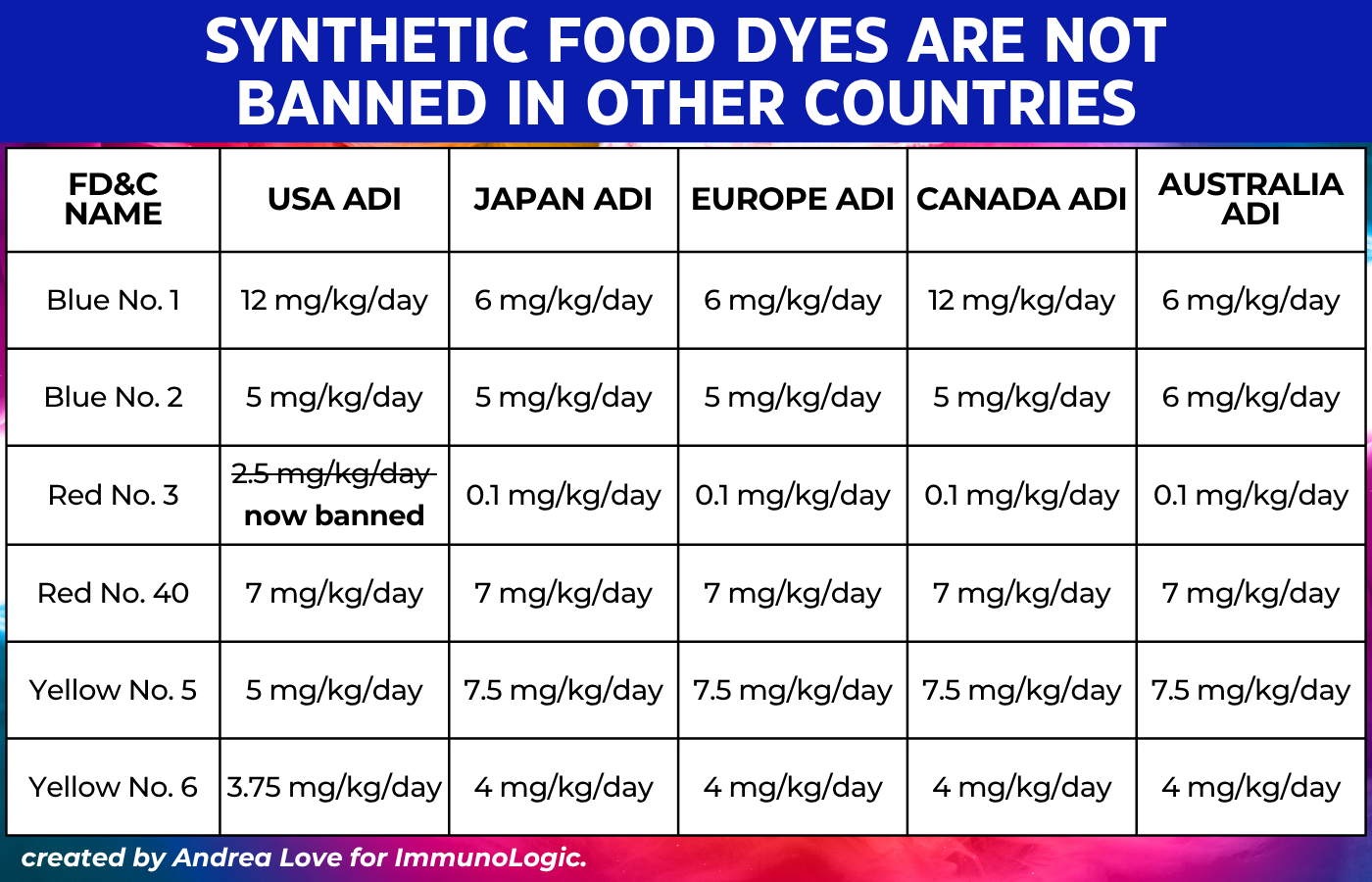
These food colorings are well-studied and have extensive safety data.
(read more in the below article)
These dyes aren’t being replaced because there’s evidence they’re unsafe.
They’re being removed because they’re synthetic.
All of these global expert agencies have affirmed and reaffirmed the safety of these colorings over and over again. So much so that I created a database on my website listing all of the safety studies by country and their current legal status in each.
Wellness influencers like Vani Hari (aka “Food Babe”) love to stoke fear about food ingredients: it’s been their income stream for decades. So under public pressure stoked by influencers, “clean label” marketing, and now, our government, these companies are caving, not because of real safety concerns, but because we live in a capitalist society and they are afraid to lose customers.
These ingredients the Trump Administration are demonizing do not pose health risks to humans at any levels we would be exposed to.
ADI levels are set incredibly conservatively to ensure that any sensitive populations are captured in safety data (for how these are calculated, read here).
Even a meta-analysis circulated as “proof” food colorings cause hyperactivity or ADHD symptoms does not conclude that. The authors explicitly state that any reported behavior changes were weak, inconsistent, subject to bias (because parents were reporting perceived symptoms), and not generalizable.
When correcting for other variables (like the fact colorings are often found in desserts and candies, which also contain added sugars), the possible relationship between food colorings and behavior changes is even weaker. Other studies used as evidence are animal studies where animals are given megadoses of these ingredients—thousands of times higher than what a person would even theoretically be able to ingest.
Not only is the dosage unrealistic, but non-human animals are not people: that’s why you can eat onions and garlic to your heart’s content but these foods are incredibly toxic to your cats and dogs even at small doses.
The food dyes they’ll be replaced with? Natural chemicals that are less studied, less stable, and more expensive.
In this big “win” for MAHA, these individual companies have committed to replacing these dyes with “natural” ones like chemicals extracted from cochineal, annatto, turmeric, beet, and spirulina. That’s not a win for health or food safety.
These colorings are:
Less stable. Most of these chemicals are photo- or oxidation-sensitive, meaning they will degrade and fade in sunlight or when exposed to air. (fade in sunlight or over time) which reduces shelf life of foods and increases food waste. That means higher costs of food and more food product reformulation will be required.
Less consistent. Since these dye chemicals are harvested from insects and plants, the chemical compositions vary dramatically. Chemical concentrations vary by every single extraction, crop, climate, meaning unpredictable coloring, reduced shelf life, and impacted quality control of food products.
Less effective. Similar to the consistency issue and the stability, since these colorings have more variability and limited quality control, it also means their pigment properties are less vibrant. That means more of these chemicals must be used in food products to obtain similar and reproducible appearances. That also drives food costs up, in addition to increasing our dosage of these (as MAHA people put it) ingredients that serve no purpose.
Less studied. Many natural dye chemicals do not have decades of toxicological data that synthetic colorings do. They fall into regulatory loopholes from being “naturally-derived,” much like the way pesticides used in organic farming do.
For example, the recently FDA-approved gardenia blue (genipin) has been touted by Marty Makary (the ideologue heading FDA at the moment) as a ‘win’ because it’s a naturally-derived dye. But there are no large-scale studies on carcinogenicity, reproductive toxicity, or developmental impact in any rigorous peer-reviewed toxicology databases. And based on the chemical identity (it is a reactive aldehyde), there are some mechanistic concerns about safety. But hey! It’s natural, so it’s gotta be good, right?
Less safe. Natural does not mean safe. That’s the appeal to nature fallacy. Arsenic is natural. Snake venom is natural. Belladonna is natural. Many colorings derived from natural sources don’t have rigorous safety studies, but beyond that, many are known to be less safe already. For example, cochineal (carminic acid) and annatto have known allergenicity among the public, whereas synthetic alternatives that are demonized have no demonstrated allergenic properties.
More expensive. Since these colorings must be harvested from organisms (plants and animals), that means land is needed to produce those organisms. That means more production costs, more extraction costs, more complex extraction and purification processes, and lower yield. In many instances, the costs of these colorings from ‘natural’ sources can be up to 100-times more than those that can be created using chemical synthesis.
Oh and these extraction processes? They’re also done in the lab—after trees or plants or insects (and the plants they live on) are clear-cut to harvest these chemicals that they produce in relatively low concentrations. For example, it takes about 70,000 cochineal insects to produce one pound of cochineal dye.
More ecologically damaging. Despite the greenwashing of these ‘natural’ chemicals, it is actually far worse for the environment than synthesis of dyes using efficient and low cost methods. This is because the dyes in these organism are usually chemicals they produce at low levels—so they need to be extracted, processed, and concentrated. To do that at scale, that means acres and acres of farmland, which also means lots of soil depletion, pesticide use, and clearing land that could be preserved.
Cochineal insects only live on prickly pear cacti — which means to produce this dye, you need acres and acres of prickly pear plantations. That means clearing wild land to grow monocultures (the same thing anti-agriculture people are opposed to, right?) and the harvesting of the insects requires intensive manual labor and kills plants and insects along with it. these require increased land use and killing and harvesting of plants and other species)
These dyes aren’t better. They’re just marketable.
The reason humans (scientists) shifted away from natural colorings over generations is because we learned about chemistry and were able to accomplish the same goals with better, safer, and more efficient tools.
This would be like if clothing companies went back to using true indigo (Indigofera tinctoria to dye jeans blue, even though the process killed countless plants, used excessive land, required labor-intensive and noxious chemical extraction processes, and exposed workers to higher levels of chemicals with more health risks.
Unfortunately, objective reality doesn’t seem to matter in this era of policy based on vibes and TikToks instead of science.
The appeal to nature isn’t just wrong, it’s dangerous. And it applies to food colorings too.
The rhetoric about swapping to natural food dyes centers around the appeal to nature fallacy, one of the oldest and more harmful pseudoscientific beliefs.
The appeal to nature fallacy is the false belief that something “natural” is inherently safer or healthier than something synthetic.
As soon as you apply basic chemistry and toxicology principles, you can understand why this is false. However, this belief is so incredibly pervasive that even people who truly believe they adhere to the tenets of scientific evidence fall prey to the appeal to nature fallacy.
Cyanide is natural. So is arsenic. So is aflatoxin. So is snake venom. So are bears.
Parabens are synthetic preservatives with a hundred years of safety data compared to ‘natural’ alternatives like grapefruit seed extract which is less effective and has high rates of allergenicity.
Many “natural” dyes are unregulated and not subject to the same FDA batch-testing as synthetic dyes.
Many synthetic pesticides used in conventional farming are substantially safer than naturally-derived pesticides used in organic farming.
I’ve written about it many times, read one article below:
This rhetoric is rampant in food and health policy—and not just in the US. People are embracing a dangerous trend of romanticizing the time before we had food preservation, vaccines, or even basic understanding of chemistry.
Campylobacter is all natural so we don’t need to pasteurize milk.
Measles is all natural so we don’t need vaccines.
Cochineal is all natural so we can just swap it for Red 40.
What could go wrong? Well, a lot. First:
Natural colorings are still chemicals. And your body does not care whether a chemical is natural or synthetic.
Cochineal (cochineal carmine) is a red dye extracted from crushed scale insects. The coloring itself comes from a chemical in these insects called carminic acid.
Cochineal is also a known allergen. Among people with routine exposure to cochineal, between 8 to 40% of the population have evidence of allergies, asthma, or anaphylaxis. Among people with known urticaria (allergy-associated hives), roughly 8% had reactions to cochineal. Products containing cochineal in the US require a warning label because of this allergenicity risk.
But hey! It’s natural—and a great replacement for Red 40 that has no established allergy mechanism (that’s sarcasm, by the way). It’s also not an acceptable coloring for vegan, kosher, or halal foods, since it is derived from insects.
When policy is shaped by how natural something sounds instead of how safe something is, we have officially lost the plot.
This is not unique to the current Trump administration and MAHA—policy by vibes is a phenomenon that crosses all ideologies. I have written about how medical organizations like the AAP and Democratic policymakers have done the very same thing (here, here, here for a few examples). All of it, regardless of the source, undermines science and public health.
MAHA is policing popsicles to distract from their erasure of real public health
Convincing one company to swap the coloring used in their ice cream for another more expensive and less-tested one is going to have zero impact on health of our country. Well, that’s not entirely true. Because these headlines are a distraction from what they are actually doing at a Federal level, which is a lot of objectively bad things. While they’re busy crowing about the type of fat fast-food fries are going to be cooked in, here’s what they are actually doing:
The Trump administration and MAHA gutted nutrition programs
Section 10011 of OBBBA repealed the SNAP Nutrition Education and Obesity Prevention Grant Program (SNAP-Ed). This program provided nutrition education and obesity prevention support for low-income families. Eliminating this program removes funding to state agencies and community partners that offered evidence-based nutrition education for vulnerable populations.
The CDC’s Division of Nutrition, Physical Activity, and Obesity (DNPAO) was cut by $122 million. This erases funding for programs that actually help people eat well and prevent chronic disease. This reduces community grants, school health initiatives, and surveillance efforts like the Behavioral Risk Factor Surveillance System (BRFSS).
The OBBBA also cut $295 billion from SNAP (supplemental nutrition assistance program). SNAP provides grocery financial assistance for our at-risk and low income families. This will worsen food insecurity and increase risk of malnutrition for millions.
The Trump administration and MAHA erased healthcare for millions
The OBBBA also erases $1 trillion dollars from Medicaid over the next decade, which will cause 12 million Americans to lose their health insurance. Medicaid covers 25% of all Americans. Medicaid is the largest provider of long-term nursing care and birth-related healthcare in the US. 40% of births in the US are covered by Medicaid. This will disproportionately impact low-income families, children, post-partum and disabled individuals, and the elderly.
OBBBA restricts Title X clinic (including Planned Parenthood), meaning many rural and low-income communities will lose their sole health care center. Title X clinics are healthcare centers that provide both primary care and reproductive and family planning care for underserved communities. Many of these are Planned Parenthood centers in rural communities that serve as general care providers in addition to providing STI testing, contraception, and cancer screening services. No funding? No healthcare. For millions.
The Trump administration and MAHA is gutting scientific research and infrastructure
I’ve written about these topics more extensively, so check out the below articles, but suffice it to say that gutting research funding will cause a mass exodus of my fellow scientists, lead to brain drain, and kneecap our research progress for decades to come.
That means no new innovations, developments, and therapeutic interventions for pretty much every single health-related issue.
But hey—at least the red coloring in your Lucky Charms is now from bugs!
Public bullying of companies is not health policy
None of these “MAHA Wins” have anything to do with Federal policies, either. They are bragging about bullying companies in the court of public opinion—which has been RFK Jr’s career strategy for 40 years.
Our government agencies are patting themselves on the back for using pseudoscience as a distraction for their failures. Instead of being actual leaders, they are pretending one food ingredient is to blame for health disparities, while ignoring social determinants of health: poverty, food insecurity, education, income inequality, medicine access, or our capitalist health insurance system.
If they actually wanted to improve health, we would see:
Funding for evidence-based programs.
Protecting and expanding access to healthcare.
Affirming the safety of vaccines and medicines
Strengthening regulatory oversight
Improving scientific infrastructure.
Resisting and fact-checking pseudoscience claims
The Trump Administration and MAHA are doing the opposite, making Americans objectively less healthy.
Science-based policy means recognizing what’s actually dangerous—and what’s not. It means focusing on the complex and labor-intensive projects that actually keep people alive and healthy. It also means not putting the responsibility on individuals that are impacted by systemic barriers.
You can’t “pull yourself up by your bootstraps” when you have no healthcare, no living wage, no support systems, and you’re handed a $6 box of beet-colored cereal in place of public health.
Policymakers have traded science and evidence-based decisions for optics and marketing campaigns—and put all of us in harm’s way.
Now, more than ever, we all must join in the fight for science.
Thank you for supporting evidence-based science communication. With outbreaks of preventable diseases, refusal of evidence-based medical interventions, propagation of pseudoscience by prominent public “personalities”, it’s needed now more than ever.
More science education, less disinformation.
- Andrea
ImmunoLogic is written by Dr. Andrea Love, PhD - immunologist and microbiologist. She works full-time in life sciences biotech and has had a lifelong passion for closing the science literacy gap and combating pseudoscience and health misinformation as far back as her childhood. This newsletter and her science communication on her social media pages are born from that passion. Follow on Instagram, Threads, Twitter, and Facebook, or support the newsletter by subscribing below:





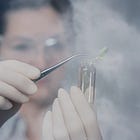
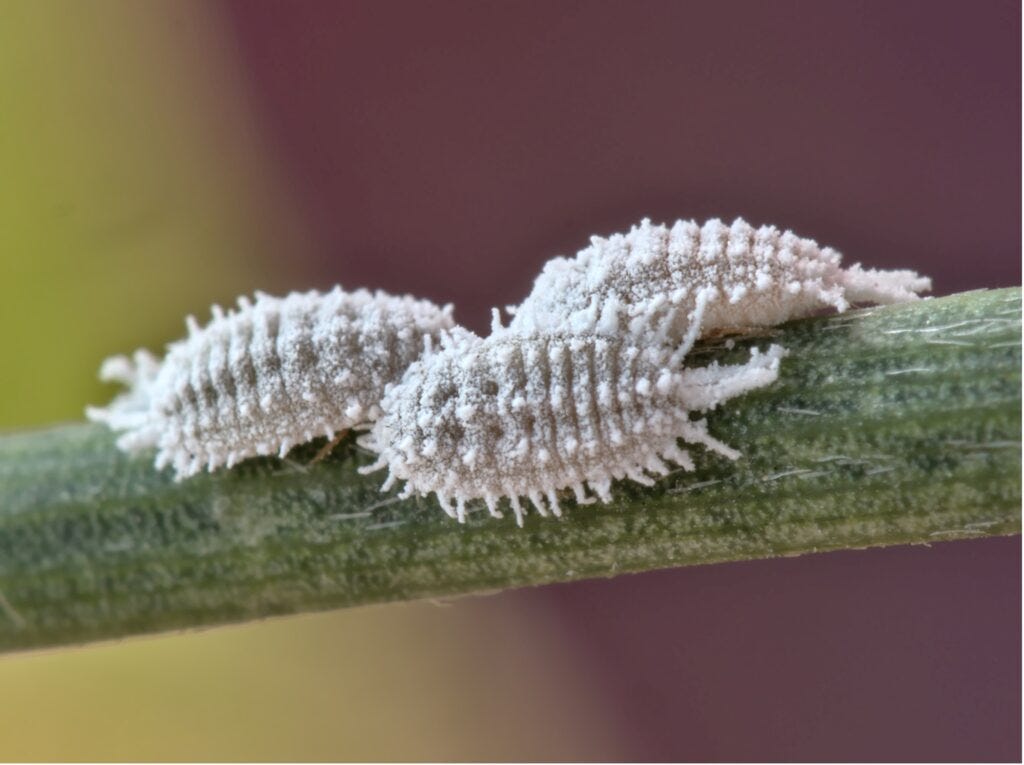
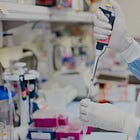
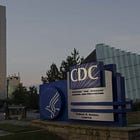
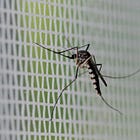
Dr. Oz's solution: Just stay healthy, and don't eat carrot cake.
I wish I had thought of that before needing seven-level spinal fusion surgery, or my wife before getting breast cancer. (I never eat carrot cake, but that didn't seem to help.)